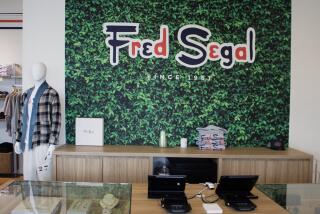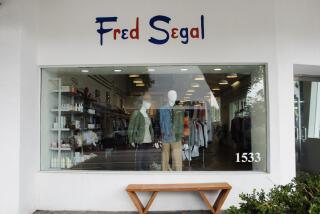Going, Going, Gone : Fashion: The liquidation auction and closing of B. Altman in New York comes as a warning to other retail giants: no one is safe.
NEW YORK â On a rainy January day, the Italianate palazzo that houses what is left of the B. Altman & Co. department store stands as an anomaly. Surrounded by blocks of discount shoe shops, Korean import-export firms and cut-rate rug merchants, it represents a more gracious era in Fifth Avenue retailing history when taste was conservative, service was a top priority and the atmosphere was refined.
Indeed, the old B. Altman was a model shopping experience with a national reputation.
âAs a person from the East, I look at Altmanâs as a memory of something lost,â said Gregg Sloate, a Los Angeles-based retail analyst for Seidler Amdec Securities. âSo many people in Southern California are from New York or go there often and shop there. The store was a real destination. Loyal customers consider it a loss.â
Some of those customers mourned that loss at last Fridayâs liquidation of the storeâs entire stock--from the permanent crystal chandeliers to the signature shopping bags. The closing was set in motion Nov. 17 when a New York bankruptcy court ruled that the L. J. Hooker Corp., part of an Australian real estate conglomerate, could close the flagship store along with five of the six branches and liquidate the inventory.
Short on cash, Hooker had been looking for a buyer for Altman for a month and had not found a satisfactory bidder for the properties, which the Australian real estate concern acquired in a leveraged buyout in the fall of 1987.
For loyal customers, many in their 50s and 60s, last Fridayâs auction was a sad scene. For others, the closing was a look at a worst-case scenario that could befall a number of retail giants.
But it was sentimental memories, not business concerns, that brought many of the 300 or so bidders to the Altmanâs auction. The storeâs famous Christmas window displays sparked particularly strong memories.
John Clark, 33, a federal parole officer from Mineola, Long Island, came to the store hoping to buy something from the legendary holiday displays--life-size bears, dogs and cats on revolving pedestals, and a Santa Claus--he had grown up seeing at Christmas. âI took the day off from work because I wanted to be in the store for one last time,â he said. âBuying something here that you can keep is part of the letting-go process.â
Clark watched as a Santa Claus figure went for $350. The auctioneer recorded the bids and his assistant held items in the air for the crowd to see. Two owls with rotating eyes sold for $30 each. Stuffed bears went for $25 apiece. An elvesâ workshop sold for $15. Seven Christmas trees made of artificial citrus fruit sold at $40 each, and a miniature Goodyear blimp flew off for $40.
Finally, John Clark did get his hands on some Altmanâs mementoes. For $100, he bought two cats on rotating platforms, another platform with a cat and a dog, and a wooden hand-drawn wagon from an old Christmas window display. âIâm giving one of the cats to my mother-in-law. My wife and I will decorate with the other two, and the wagonâs going in the back yard,â he said.
Other Christmas decorations from the 124-year-old store are now earmarked for Poland. Jacques Tourel, a French businessman, purchased four complete Christmas windows--detailed scenes of a toy shop, a bakery, a dressmakerâs studio and a holiday ball--at a bargain price, less than $2,000 each. The Frenchman has a contract to import a wide range of consumer goods to department stores in Poland, and the window displays, he says, will be a crucial part of his merchandising strategy.
âWeâre planning displays for the store windows over there,â said Tourel, âbecause theyâre just beginning to introduce Christmas commercially. We want to bring a part of that tradition to Eastern Europe. Altmanâs had an old-fashioned way of promoting the holidays, and people in Poland, whoâve only been able to celebrate at home under communism, should be able to appreciate that.â
Store employees said Tourel was one of the biggest buyers at the liquidation auction. Right behind him was Dr. Clorita Herrera, a Manhattan internist who spent about $50,000 on such items as a 10-foot mahogany table from the storeâs regal wood-paneled boardroom, along with 14 hand-carved chairs and a Waterford crystal chandelier.
âWhen I first came to the United States from the Philippines in 1961, I was a poor intern,â Herrera said. âI would wait until I had enough money so I could buy at Altmanâs. The service was superb.â
Herrera admitted that she stopped buying clothes at Altmanâs years ago. âThey were just too conservative, too staid,â she said, âbut what I remember most about the store was its grandeur. You knew you were in a different world.â
âIt was a great family feeling,â said Lenore Silberstein, who worked in the storeâs internal audit department. âEspecially among the old timers.â Many of them worked for 30 or 40 years at the Fifth Avenue flagship store, she said.
Following instructions set down in the will of Benjamin Altman, who died in 1913, the store was operated as a charitable foundation. Employees cite that special status, and excellent labor-management relations, as a key to Altmanâs family atmosphere: âA very pleasant, efficient kind of paternalism,â as one Altmanâs employee put it. This arrangement included subsidized lunches, ballet and theater tickets, and until recently, a fully staffed infirmary on the storeâs top floor--special touches that ended with the storeâs purchase by Hooker in the fall of 1987.
Asked why the store failed to remain financially strong, one retail executive who asked not to be named, said: âThere were a number of departments at Altmanâs that were really excellent, but you always had a sense that the place was catering to old ladies, or to people whose tastes never changed. You could always count on Altmanâs having the right plaid wool skirt, or pleated gray flannel skirt, all the basic traditional things for women that wouldnât be trendy, the kind of items that would appeal to a clientele who would be proud of the fact that they never changed their hairstyle in 30 years, and that theyâre still wearing blazers and pleated skirts or sweater sets.â
Ironically, in the mid-1980s Altmanâs hired Jack Schultz, a Bloomingdaleâs vice president, as its president to help update the storeâs image, but industry observers say that regime lacked the time to turn the store around before Hooker entered the picture.
As he watched auctioned furniture rolling away to freight elevators, Altmanâs menâs wear buyer Greg Tsombanis pointed out that the problem isnât limited to Altmanâs. âI think the lesson to be learned is that none of the great department store institutions are really safe anymore,â he said.
Because of its New York City landmark status, the 1913 building that housed Altmanâs is safe, but that protection is limited to the structureâs exterior and only those details that were in place in 1913. The buildingâs owner, KMO Realty, has received permission to add several floors to the Madison Avenue side of the structure, which it plans to use for commercial office space. The landlords expect new retail tenants to fill the Fifth Avenue side.
By 6 oâclock Friday evening, packing cases of dwarfs and elves bound for Warsaw were being loaded into trucks. Auction customers paid their bills quietly at a makeshift office in what had been one of New Yorkâs most serene shopping experiences.
More to Read
Inside the business of entertainment
The Wide Shot brings you news, analysis and insights on everything from streaming wars to production â and what it all means for the future.
You may occasionally receive promotional content from the Los Angeles Times.










